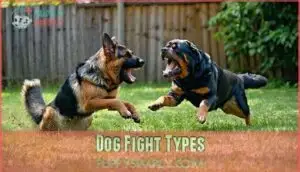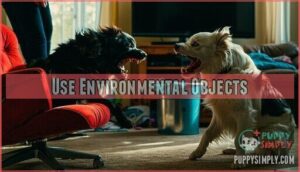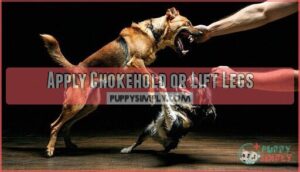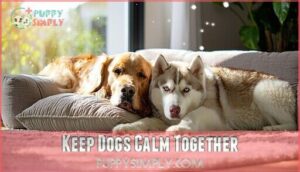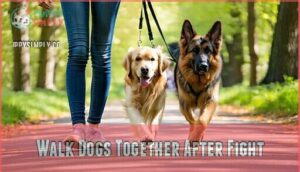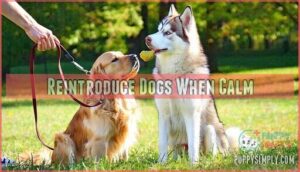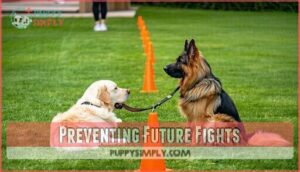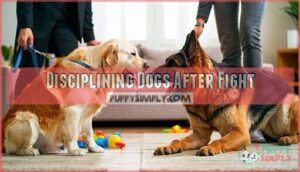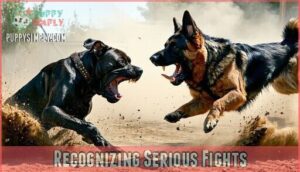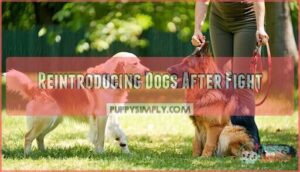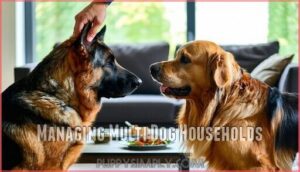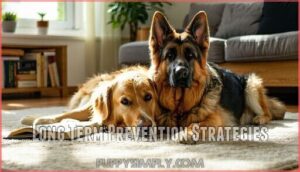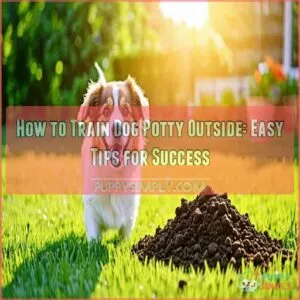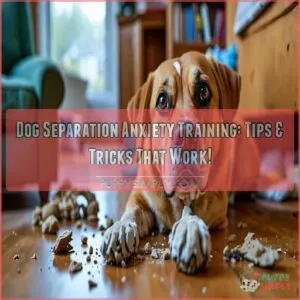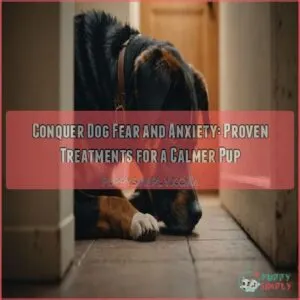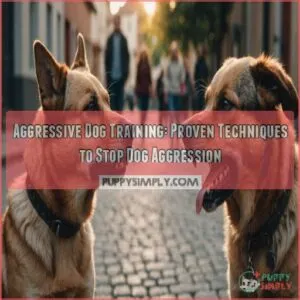This site is supported by our readers. We may earn a commission, at no cost to you, if you purchase through links.
 Disciplining dogs after a fight isn’t about scolding or punishment—it’s about guiding them back to calm behavior.
Disciplining dogs after a fight isn’t about scolding or punishment—it’s about guiding them back to calm behavior.
First, separate the dogs safely to avoid further escalation.
Once they’ve cooled off, use positive reinforcement to reward good behavior, like sitting or lying calmly.
Avoid yelling; it’ll only stress them out more.
Focus on teaching obedience commands to reinforce your leadership, which helps prevent future conflicts.
Pinpoint what triggered the fight—maybe a toy or another dog—and work on managing those triggers.
Remember, patience and consistency are key.
Stay tuned for expert tips on reintroducing dogs and building harmony in multi-dog households.
Table Of Contents
- Key Takeaways
- Dog Fight Types
- Breaking Up Fights
- Post Fight Handling
- Preventing Future Fights
- Disciplining Dogs After Fight
- Recognizing Serious Fights
- Reintroducing Dogs After Fight
- Managing Multi Dog Households
- Long Term Prevention Strategies
- Frequently Asked Questions (FAQs)
- Should I punish my dog after a fight?
- Do dogs forgive each other after a fight?
- What to do immediately after a dog fight?
- Can dogs go back to normal after fighting?
- How do I know if my dog is fighting out of aggression or fear?
- What are the long-term effects of disciplining my dog after a fight?
- Are there any signs I should look out for that could indicate my dog is about to fight?
- How can I prevent my dog from fighting in the future?
- What should I do if my dog is the aggressor in a fight?
- How to handle redirected aggression during fights?
- Conclusion
Key Takeaways
- Focus on calming both dogs down after a fight instead of punishing them. Separate them safely and use positive reinforcement to reward peaceful behavior.
- Identify the triggers that caused the fight, like resource guarding or territorial issues, and address them directly to prevent future conflicts.
- Gradually reintroduce the dogs in a neutral setting with leashes, praising and rewarding calm interactions to rebuild trust.
- Monitor their interactions closely, use consistent training to establish leadership, and call a professional if fights keep happening.
Dog Fight Types
You’ll need to know the specific type of fight your dogs had to use the right discipline method.
Understanding whether it was a dustball fight, bite and hold fight, or just a display fight will help you choose the most effective way to stop future aggression.
Cartoon Dustball Fights
Chaos often characterizes "cartoon dustball fights" between dogs – they’re quick, noisy scuffles with bumping and biting.
You’ll recognize them by their fast-moving nature and relatively minor damage.
These fights pose the highest human bite risk when you intervene at the wrong time, despite their playful aggression appearance.
Dustball triggers can include resource guarding or territorial disputes, and understanding this dog behavior helps with intervention timing and keeping everyone safe while managing dog aggression effectively.
Bite and Hold Fights
Unlike quick dustball scuffles, bite and hold fights are far more dangerous.
In these confrontations, dogs grab and don’t let go, causing severe injuries through tearing damage.
You’ll see one dog latch onto another, often thrashing to maximize harm, and these situations demand immediate intervention urgency and likely veterinary attention afterward.
Understanding this type of dog aggression helps determine appropriate postfight discipline and necessary training implications for preventing future incidents.
Display Fights
While bite and hold fights cause serious injuries, most confrontations between dogs are actually display fights.
These look scary but rarely cause harm.
Display fights involve:
- Dramatic posturing signals with raised hackles
- Loud vocalization intensity that sounds worse than it is
- Stiff body language and direct staring
- Brief contact without intent to injure
Understanding pack dynamics helps you recognize when dogs are just setting boundaries through these displays.
Breaking Up Fights
You’ll need to act fast yet stay calm when your dogs start fighting to prevent serious injuries.
Having a planned strategy with proper techniques will help you safely separate the dogs without putting yourself at risk, using a planned strategy.
Stay Calm During Fights
During a fight between your dogs, your emotional state directly affects their behavior.
Dogs sense Human Reactions through Emotional Contagion – if you panic, they escalate.
Take deep breaths and maintain a steady voice for effective Fight De-escalation.
Your calm demeanor improves Clear Thinking, helping you make safer decisions during dog fight intervention.
Remember, steady nerves lead to calm dogs and better dog fight safety outcomes.
Use Environmental Objects
Now that you’re calm, grab nearby objects for dog fight separation.
Large items like chairs, cushions, or trash cans work perfectly as barrier techniques.
Quickly insert these improvisation tools between the fighting dogs like a battering ram.
It’s essential to have resources available for safe dog fight separation.
You’ll have just 2-3 seconds after safe separation to gain physical control.
Keep extra leashes handy to prevent re-engagement.
Remember, effective fight disruption requires swift action with object safety in mind.
Apply Chokehold or Lift Legs
Using a chokehold or lifting legs during a dog fight isn’t safe or ethical.
Chokehold dangers include harming the dog or misapplying pressure. Leg lift risks like injury prevention failure make these improper techniques.
Instead, focus on safer methods, like distraction or barriers, to break up dog fights.
You can intervene without endangering dogs or yourself, using distraction to effectively manage the situation.
Post Fight Handling
After a fight, it’s vital to help your dogs calm down and feel secure again.
Handling the aftermath with care prevents further stress and also helps rebuild trust between them.
Keep Dogs Calm Together
After a scuffle, create a calm environment by keeping both dogs in the same space.
It may feel counterintuitive, but separating them immediately can prolong tension.
Use safe spaces and quiet tones to encourage relaxation.
Routine consistency helps calm dogs after a fight.
Many owners find calming aids useful in these situations.
Shared activities, like sitting nearby, rebuild positive association and ease stress, especially in multidog households.
Walk Dogs Together After Fight
After a tussle, taking both dogs on a leash walk works wonders.
A calming walk benefits their mindset, allowing tension to melt away.
Keep a safe walking distance initially, but move side-by-side to rebuild harmony.
Leash walking tips? Stay steady and avoid sudden pulls.
Post-walk behavior often reveals relaxation—dogs forget squabbles quicker when shared activities follow, leading to a more relaxing environment.
Reintroduce Dogs When Calm
When both dogs have calmed down, it’s time to reintroduce them with care. Gradual exposure is key to avoiding another clash.
- Start in a neutral spot with leashes for supervised interactions.
- Use positive associations like treats or praise to encourage good behavior.
- Observe body language and increase distance if tension builds.
Patience keeps reintroducing dogs safe and peaceful.
Preventing Future Fights
Preventing fights starts with understanding what triggered the last one and addressing it directly.
When you remove the cause and set clear boundaries, you’ll create a safer, calmer environment for your dogs.
Identify Fight Cause
Understanding what sparked the fight is key to preventing more.
Was it territorial behavior, dominance struggles, fear aggression, resource guarding, or even a pain response? Watch for patterns like a toy or food disputes, or certain spaces.
Discipline dogs effectively by focusing on triggers, not punishment.
Identifying the cause of fights helps in keeping aggressive dogs calm and improving harmony.
Remove Fight Cause
When you pinpoint the dog fight causes, tackle them head-on.
Removing the source of tension improves peace.
- Resource guarding: Feed dogs separately to avoid clashes.
- Territorial aggression: Define personal spaces or rotate areas.
- Pain triggers or anxiety management: Visit the vet or use calming tools.
Addressing dog fight triggers helps eliminate future scrapes and sets the stage for harmony.
Establish Dominance
To prevent dominance struggles after a dog fight, focus on Pack Leadership through Canine Hierarchy.
Confidence Building starts with Consistent Rules—control sleeping spots, treats, and walks.
Resource Control is key: only reward calm, respectful behavior, which supports long-term dog behavior modification.
Use dog training to reinforce obedience, teaching your dog proper boundaries, and establish a stable dominance hierarchy that reduces tension.
Disciplining Dogs After Fight
When disciplining your dog after a fight, it’s important to stay calm and avoid harsh punishment. Focus on guiding them toward better behavior using positive reinforcement and clear commands.
Avoid Punishing Dogs
Punishment after dog fights damages trust and increases aggression, making Reinforcement Training essential.
Dogs learn better when they feel safe, not scared. Instead of punishing, focus on calming emotions and Behavior Modification.
Here are three reasons to avoid punishment:
- It worsens aggression.
- Breaks down trust.
- Erases progress in Behavior Modification.
Stick with Positive Alternatives for healthier dog behavior!
Use Positive Reinforcement
Reward good behavior immediately after a fight to rebuild trust and calm your dog.
Rebuild trust by rewarding calm behavior right after a fight—peaceful moments pave the way for lasting harmony.
Use training treats or a clicker as part of consistent reinforcement.
Positive reinforcement works wonders when paired with small, simple commands.
Ignore bad behavior you don’t want repeated.
Dog socialization and reward-based training help your dog learn that peace earns rewards faster than conflict.
Teach Obedience Commands
Teaching obedience commands helps settle aggression after fights.
Focus on verbal corrections paired with reward-based training.
Commands like "leave it" or "stay" create structure and trust.
Use routine management to reinforce new behaviors, and confirm command consistency.
Leash control during training sessions builds focus.
Practicing dog training techniques daily keeps your dog mentally stimulated and more cooperative.
Positive reinforcement, like using small, healthy treats, can be highly effective, and is a key part of positive reinforcement and leash control.
Recognizing Serious Fights
Knowing when a dog fight is serious can prevent injuries and stress for everyone involved.
Watch for tense bodies, tight lips, and quick, focused movements that signal true aggression instead of harmless squabbles.
Tense Body Language
Spotting tense body language can help you identify serious dog fights.
Look for stiff posture, tight muscles, raised hackles, or a frozen stance. A whale eye (showing the whites) often signals brewing canine aggression.
Recognizing these signs early lets you step in before a fight escalates.
Understanding dog tail positions can also provide insights into their emotional state.
In dog fights, understanding body language is key to safely breaking up aggressive behavior.
Tight Lips or Snarling
Tight lips or snarling often signals heightened tension in a dog fight.
These facial expressions show their intent and readiness to escalate.
Pay attention to lip position—it’s a clear sign that bite inhibition is low.
Snarling signals demand immediate action to assess the threat.
Stay calm, avoid panic, and focus on breaking up dog fights safely to protect everyone involved, ensuring a safe resolution with immediate action and maintaining calm demeanor.
Efficient Fast Movements
How can you tell a real dog fight? Serious fights involve quick, precise actions, unlike exaggerated play.
Watch for:
- Fast, efficient movements—no bouncing or playfulness.
- Purposeful bites and slams—not playful nips.
- One-sided aggression—no role-switching like in play.
Early socialization helps dogs develop appropriate play behaviors and reduces the risk of future aggression.
Movement efficiency training and fast reaction drills can help you spot danger quickly, giving you a fight speed advantage.
Reintroducing Dogs After Fight
When reintroducing dogs after a fight, patience is your best tool. Start in a neutral space, keep them calm, and watch for signs of tension to prevent setbacks.
Neutral Location Reintroduction
After serious dog fights, a safe reintroduction is key. Start in a neutral location where no dog feels territorial.
Keep them on leashes, maintaining a controlled environment. Allow scent familiarization first, then continue with gradual exposure.
Use calm, supervised interactions to rebuild trust and support dog socialization. Proper equipment like durable walking leads are essential for control.
Patience helps each dog feel secure without escalating tension further, which is crucial for a successful reintroduction.
Increase Distance at Aggression
When you notice early aggression signs during reintroduction, increase the distance between the dogs immediately.
This helps create a safe space for both, reducing stress. Gradual proximity increase is key, ensuring a calm atmosphere.
Use supervised interactions only, staying alert for further tension. Controlled reintroduction after dog fights is a vital step in dog fight prevention and deescalation.
Reintroduction should be done carefully to prevent further aggression, ensuring a calm and peaceful environment for both dogs.
Allow Unsupervised Interaction
Building trust after a dog fight takes time. Gradual freedom is key before allowing unsupervised interaction.
Follow these steps:
- Monitor progress for signs of harmony.
- Watch for early signs of tension, like stiffness.
- Address resource guarding to prevent triggers.
- Make certain fights decrease to zero aggression.
- Delay unsupervised time until behaviors truly improve, guaranteeing safety.
Patience fosters prevention and handling success. Owners should also be aware that fear triggers aggression.
Managing Multi Dog Households
When you’re managing a household with multiple dogs, keeping the peace takes ongoing attention.
By watching their interactions closely and addressing issues early, you can prevent conflicts from turning into bigger problems.
Monitor Dog Interactions
After a dog fight aftermath, keeping an eye on subtle signals like stiff body language or resource guarding is key.
Dogs often show early warnings before aggression erupts. Stay alert during play or meals—these moments often spark trouble.
Trigger identification helps with early intervention, ensuring dog safety. Watching their interactions prevents dog injuries and helps foster calm dogs after fights, which is crucial for dog safety.
Address Repeated Fights
Repeated dog fights can spiral into unmanageable aggression if left unchecked.
Tackle the issue by closely monitoring households and establishing routine management. Watch for escalation signs and make adjustments to prevent dog fights.
- Separate dogs after tension rises.
- Adjust routines to minimize triggers.
- Track patterns in aggressive behavior.
- Prevent dog fights by identifying stressors and removing them early.
Seek Professional Help
If fights keep happening, it’s time to seek professional help.
A skilled dog trainer, behaviorist, or animal behaviorist can assess what’s causing aggression.
Their behaviorist expertise helps with behavior modification, while Trainer Qualifications guarantee safe, specialized training.
They may suggest medication options for severe cases.
Resolving difficulties becomes easier with help, giving you peace of mind and your dogs a safer home.
Long Term Prevention Strategies
Preventing future fights means understanding your dogs’ triggers and taking steps to stop trouble before it starts.
With the right strategies, you can teach your dogs to stay calm, avoid conflict, and build a peaceful routine together.
Predict and Prevent Aggression
Spotting tension early can save headaches later.
Watch for aggression triggers like food or toys and identify what sets your pup off.
Start with these:
- Trigger Identification: Notice subtle cues like stiff body language.
- Early Intervention: Redirect attention before escalation.
- Resource Management: Limit access to hot-button items.
- Communication Signals: Learn your dog’s signals to keep peace.
Redirect Dogs to Alternative Activities
When tension spikes, redirecting is key.
Engaging your pups with puzzle toys, training games, or scent work helps shift focus and promotes calm dogs after a fight.
Here’s a quick guide:
| Activity | Why It Works | Extra Tip |
|---|---|---|
| Puzzle toys | Mental engagement | Rotate weekly for novelty |
| Training games | Builds obedience | Reward with treats |
| Chew alternatives | Eases anxiety | Use safe, durable options |
The table provides a clear overview of activities that can help calm your dogs, including chew alternatives and scent work is not in the table but training games is.
Teach Submissive Dogs to Retreat
Building a submissive dog’s confidence is key.
Teach retreat by pairing a “time out” command with treats, creating a Safe Retreat Space they associate with calmness.
Use Command Training like “sit” and “stay” to reinforce control during tense moments, avoiding confrontation.
To help with commands, start with short training sessions to keep your dog engaged.
Early intervention helps prevent escalation, while consistent Confidence Building keeps your dog feeling secure and reduces the chance of future fights.
Frequently Asked Questions (FAQs)
Should I punish my dog after a fight?
It’s tempting to react strongly, but punishing your dog after a fight is like closing the barn door after the horse bolts.
Instead, focus on calming them down, understanding triggers, and reinforcing positive behaviors.
Do dogs forgive each other after a fight?
Dogs don’t hold grudges like people do.
After a fight, they typically move on quickly and can even go back to being friends.
Their focus is on the present, not past conflicts.
What to do immediately after a dog fight?
Act swiftly but calmly: separate the dogs safely using a barrier or lifting hind legs, then check for injuries.
Keep both dogs in the area to relax, avoiding isolation or punishment, and comfort them patiently.
Can dogs go back to normal after fighting?
Fights don’t ruin relationships forever.
Dogs usually forget quickly and can return to normal with time, calm reintroductions, and positive interactions.
Stay patient, follow your reintroduction plan, and keep emotions steady to rebuild trust.
How do I know if my dog is fighting out of aggression or fear?
You can tell by watching body language.
Aggression shows stiff posture, snarling, or lunging.
Fearful dogs tuck tails, avoid eye contact, or cower.
Look for these signals to understand your dog’s emotions during conflict.
What are the long-term effects of disciplining my dog after a fight?
Imagine pouring gas on a campfire—it’s what disciplining after a fight does.
Scolding creates fear, damages trust, and worsens aggression.
Instead, focus on calming them down and using positive reinforcement to rebuild their confidence.
Are there any signs I should look out for that could indicate my dog is about to fight?
Watch for tense posture, a fixed stare, ears pinned back, or lip curling.
If your dog suddenly freezes or stiffens, it’s a clear warning sign.
Subtle growls or hackles rising also suggest a fight brewing.
How can I prevent my dog from fighting in the future?
Stopping fights feels like defusing doggy drama.
Stop triggers like food fights, territorial tussles, or jealousy.
Train commands, reward calmness, and supervise interactions.
If needed, work with a professional trainer.
Redirect tension with toys or walks.
What should I do if my dog is the aggressor in a fight?
Stay calm and firmly control your dog using a leash or harness.
Redirect their focus with a clear command. Avoid yelling or hitting, as it fuels aggression.
Prioritize safety and evaluate possible triggers afterward.
How to handle redirected aggression during fights?
Redirected aggression happens when a dog, unable to reach its target, lashes out at what’s closest.
To handle it, stay calm, avoid physical interference, and use tools like leashes or barriers to separate safely.
Conclusion
Picture your dogs resting peacefully, tensions diffused.
Disciplining dogs after a fight isn’t about punishment—it’s about guiding them toward better behavior. By staying calm, identifying triggers, and using positive reinforcement, you steer them toward harmony.
Consistent training and patience will build trust and prevent future conflicts. Remember, leadership is earned through guidance, not dominance.
With effort, your dogs can coexist peacefully, bringing balance to your household. Take it step by step—you’ve got this!

